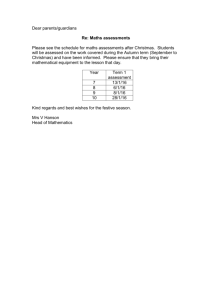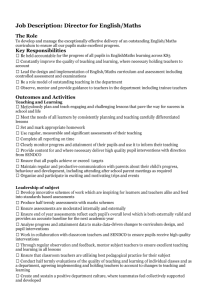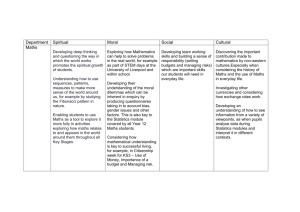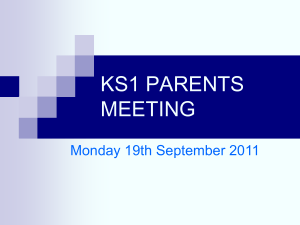The Barriers to Learning Maths
advertisement
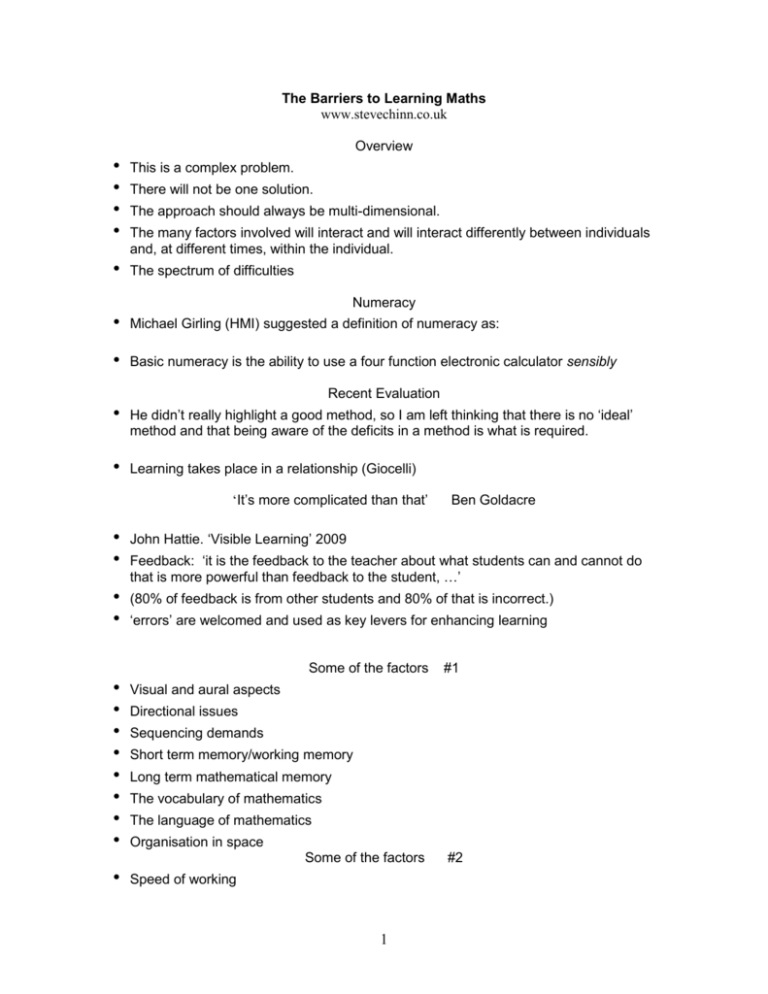
The Barriers to Learning Maths www.stevechinn.co.uk Overview • • • • • This is a complex problem. There will not be one solution. The approach should always be multi-dimensional. The many factors involved will interact and will interact differently between individuals and, at different times, within the individual. The spectrum of difficulties Numeracy • Michael Girling (HMI) suggested a definition of numeracy as: • Basic numeracy is the ability to use a four function electronic calculator sensibly Recent Evaluation • • He didn’t really highlight a good method, so I am left thinking that there is no ‘ideal’ method and that being aware of the deficits in a method is what is required. Learning takes place in a relationship (Giocelli) ‘It’s more complicated than that’ • • • • John Hattie. ‘Visible Learning’ 2009 Feedback: ‘it is the feedback to the teacher about what students can and cannot do that is more powerful than feedback to the student, …’ (80% of feedback is from other students and 80% of that is incorrect.) ‘errors’ are welcomed and used as key levers for enhancing learning Some of the factors • • • • • • • • #1 Visual and aural aspects Directional issues Sequencing demands Short term memory/working memory Long term mathematical memory The vocabulary of mathematics The language of mathematics Organisation in space Some of the factors • Ben Goldacre Speed of working 1 #2 • • • • • • Thinking style The structure of the curriculum The style of the curriculum Anxiety, expectations, self esteem, risk taking Motivation, attributional style Categorising Visual/Vision • • • • • • • • • Can they see? Does print/paper contrast/colour make a difference? (scotopic sensitivity) Is the work cluttered? Does the page look intimidating? Is the font clear? + x Are they visual learners? Do they confuse symbols? Subitizing and arithmetic skills Fischer and Hartnegg 2008 Recognising or counting from visual memory a number of dots presented for 1/10 second Lower capacity or children with problems in acquiring basic arithmetic skills Subitizing and arithmetic skills • • Fischer and Hartnegg 2008 The basic visual capacity of subitizing and number counting can be improved by daily practice. (Success rate 85%) The training transferred to arithmetic skills (7 – 13 years) Colour • • • Screening: Overlays: Crossbow Education Spoken vs Written I asked a student, ‘What is half of 50?’ She replied ’25’ Later I showed her ½ x 50 written on paper. She didn’t know the answer. I asked, ‘Is the answer bigger or smaller?’ She said ‘Yes’ Direction 2 • • • • • • Counting backwards Transposals….Hears ‘Fifteen’ writes 51 Two digit numbers 13 (1 2 3 4 5 6 7 8 9) Decimal numbers… interaction with language 5348.435 Add, subtract, multiply….. then division Direction and time • • • • • Six twenty 6:20 Twenty past six Twenty to eight...what do you need to know? Quarter to eight…. Seven and three quarters Ten to nine 8:50 Too much choice #1 • We can now write the division operation in three ways……………. • Read from left to right, ’12 divided by 3’ • 12 3 Too much choice • • Read from top to bottom ’12 divided by 3’ 12 3 Too much choice • • #2 #3 Read from right to left ’12 divided by 3’ 3 )12 Sequencing Skills • • • • • • • • Recall/retrieval of sequential information Numerical sequences 10, 20, 30……. 14, 24, 34…… Reversing the sequence Interaction with stm abcdeabcdeabcdea….. abc dea bcd eab Fraction sequence. ‘Long’ division Language sequence Sequencing and place value 3 • • • Five hundred and six thousand and eighty 500,6000,80 6580 Short term/working memory • Chunks of information (instructions, copying, methods) • • • • • Repeating information Mental arithmetic Written work Overload Link to thinking style Sequential short term memory (28 dyslexic, 27 non-dyslexic, Year 11, matched for predicted GCSE grades) • • • • • • • ‘Breakdown’ at 3, 4 and 5 items 75% dyslexics 48% controls No. failures at first items 28 (16 students) 9 (7 students) No. failures at last item 63 (23 pupils) 43 (21 students) Correlation Mathematical memory • • • • • Quick retrieval of basic facts Recall of procedures Language, for example instruction words Multi-sensory input Secure knowledge School Reports #1 • • • • I am constantly having to prompt her to look at Mrs Smith and listen to her. She seems to spend a lot of time rubbing out and sharpening her pencil! Mrs Smith paces the lessons very well and Ellie should be able to follow what she is teaching. I also feel that Ellie has become rather lazy from the point of view of always saying she doesn’t remember how to do any maths processes. She will seem to have grasped a concept yet the following lesson she will have forgotten it. I am beginning to insist that she tries to remember how to do the work. Organisation in space 4 • 2x x2 x2 1 1 • • 368 257+ 625 Write today’s date in the middle of the page Teacher-identified math weaknesses. Bryant, Bryant and Hammill, JLD, 2000 12th …. (out of 33) • Orders and spaces numbers inaccurately in multiplication and division 13th …. • Misaligns vertical numbers in columns Vocabulary and language • • • The power of first learning experiences. The language of mathematics is not English as we know it. Communication……. For all? The flexible use of vocabulary • Young girl from Belgium • ‘It’s cold today. It’s take away five degrees.’ 1 Speed of working • • • • • • Mental arithmetic Slow to start work Slow written work Less experience Impulsivity Is this a necessary expectation? Classroom study. Chinn. ‘95 • • 16 + 37 308 + 897 12.3 + 5 19.09 + 10.91 63 + 2.1 67 – 32 72 – 48 813 – 668 601 – 346 5 • • 37.6 – 4 21.003 – 2.114 5 x 6 5 x 60 33 x 20 44 x 21 25 x 202 2)39 6040 10 3)906 5)668 15)345 • • (122 dyslexic pupils, 11-13, 8 schools) (122 from upper sets of 9 mainstream schools) Speed • • • • • • Dyslexic pupils 13.00 mins, SD 5.41 Mainstream pupils 8.50 mins, SD 3.41 Anxiety survey: Ranked 4th – 7th Accuracy Dyslexic pupils 10.1, SD 5.6 Mainstream 15.6, SD 4.1 Teacher-identified math weaknesses. Bryant, Bryant and Hammill, JLD, 2000 • • Ranked 6th …. Takes a long time to complete calculations Thinking Style…. Later!! • • • • • The Structure and Style of the Curriculum It could be overly prescriptive…. Do it this way….. We spend five lessons on division and then move on…. This term we are doing fractions. Returns to topics could be too far apart. There may not be sufficient time for review. There may not be enough practice/reinforcement of ‘old’ ideas built into new topics. It may be at the abstract/symbolic stage too soon. TES April 3rd 2009 Emotions and Maths • Research by Cambridge Assessment found that the better pupils were at expressing their emotions, influencing other peoples’ feelings, networking, using social skills and general social awareness, the worse their maths results were at GCSE Anxiety and Expectations • • • Anxiety impacts on short term memory Avoiding risk.. ‘Never mind, you did your best.’ Where do expectations come from? 6 • Are ‘targets’ expectations? And is it possible to set the perfect target? • Anxiety survey: 2nd – 4th Long division Data and Scarfpin (1983) • • Mental block anxiety can be triggered by a symbol or a concept that creates a barrier for the person learning maths. Socio-cultural maths anxiety is a consequence of common beliefs about maths, such as, if you cannot learn facts you will never be any good at maths High Anxiety Items • • • • • Taking an end of term maths exam Doing long division questions without a calculator Having to take a written maths test Having to work out answers to maths questions quickly Waiting to hear your score on a maths test Dyslexic students • Averaging all Year groups: • Long multiplication without a calculator (#7) • Learning the hard times table facts (#14) • Hearing your score on a maths test (#15) Attributional Style • Permanent. ‘I’ll never be able to do fractions.’ • Pervasive. ‘I can’t do this division stuff. I can’t do any maths.’ • Personal. ‘I’m too stupid to do maths.’ Barriers to learning and attributional style • • Maths is judgmental. Right or wrong for a computation is down to the maths not to the teacher’s judgment…. But the marks awarded are within the teacher’s control. How many barriers will a learner experience before he says, ‘I just don’t get maths and I guess I never will.’ Success or 7 Failure • Specific Universal • Temporary Permanent • External Internal What do learners need to be good at maths? (Krutetskii) • • • • • • • The ability for logical thought and the ability to think in mathematical symbols. The ability for rapid and broad generalisations of mathematical objects, relations an operations. Flexibility of mental processes in maths Striving for clarity, simplicity, economy and rationality of solutions Being able to switch from a direct to a reverse train of thought Mathematical memory These components are closely interrelated, influencing one another and forming in their aggregate a single integral syndrome of mathematical giftedness. A Few Golden Rules • • • • • • Don’t create anxiety Experiencing success reduces anxiety Experiencing failure increases anxiety Understand your students as individuals Teach more than one way to do things Remember where each topic leads mathematically A few more…. • • • • • Understanding is a more robust outcome than recall Try to understand ‘errors’… don’t just settle for ‘wrong’ Prevention is better than cure Praise the work, not the learner All the above rules have exceptions! 10 year old Australian boy • “I am good at x + and – divide is sometimes hard. I would love to be a bit better at and x. If you want me to be better at maths you should show me a pattern in it like a rhyme. 8 • I like maths when I get it right. I don’t like getting maths wrong. You should show me how to get my errors right by giving me a strategy.” At what age are you noticing poor motivation and anxiety in pupils doing maths lessons? • • • • • 79 responses Age 5 8 Age 6 32 Age 7 30 Age 8 9 Reasons: (120 responses) • • • • • • • Rate as: 1 minor 2 significant 3 major Mental arith: (116) 2.34 Memorising facts: (117) 2.56 Answering quickly: (118) 2.75 Writing up sums: 2.00 (113) Other reasons • • • • • • Being asked to move on too quickly and not consolidating understanding of basics Parental pressure and expectations The change to ‘sit down’ maths Peer pressure to be ‘normal’ Absence Vocabulary and language Other reasons…. • (Cumbria) ‘Having a child with S.N.s and being forced to change schools several times, I’ve found the lack of awareness of teachers very concerning. Too quick to judge children as naughty, lazy, etc’ Visible Learning Hattie, 2009 • ‘The highest effects accrued when teachers provided feedback data or recommendations to students.’ • • • The programmes with greatest effect were strategy based methods’ Least effective were using technology for independent practice, And the strategy of working within a peer group 9


